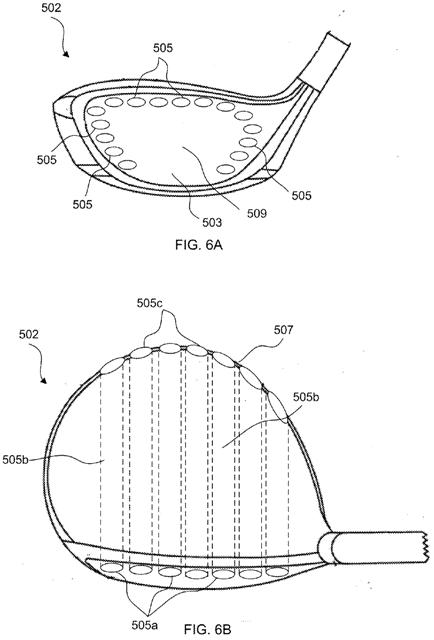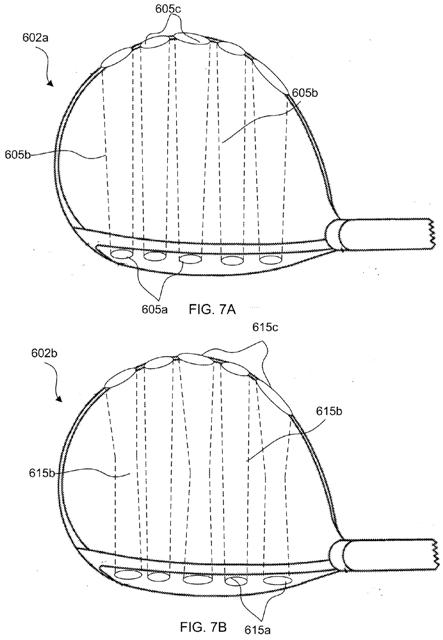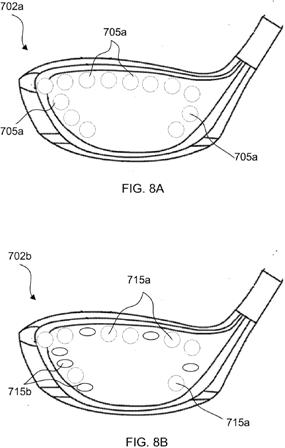The New “Wind Tunnel” Driver
Yes, I proclaimed this driver the “Wind Tunnel,” it is not the actual product name although it fits perfectly. The club design is disclosed in a patent application that recently published as US Pub. No. 20110294590 titled “Golf Club With Wind Resistant Shaft And Golf Club Head.” The application describes the invention as:



The application goes on to explain:
Interesting concept, as it has been each time I have come across it in the past. Take a look at this post and think of all the money that could have been saved if only they read the Golf-Patents blog! I wouldn't expect to see this design on store shelves, or in Tiger's bag, anytime soon.
Dave Dawsey - The Golf Invention Lawyer
Golf club, golf club shaft and golf club head structures are presented. The golf club may include a shaft having a core and an airfoil shaped skin substantially surrounding the core and in contact with the core. The golf club may further include a golf club head having a plurality of apertures formed in a front face of the golf club head and extending through an interior of the golf club head to a rear portion of the golf club head. The apertures may narrow or widen as they extend from the front face to the rear portion.



The application goes on to explain:
[0051] FIGS. 6A-8B illustrate yet another drag reducing aspect of the invention. FIG. 6A is a front view of a golf club head 502 having a plurality of holes or apertures 505 formed in the front face 503 of the golf club head 502 and extending through the golf club head 502 from the front face 503 to the rear 507 of the club head 502, as shown in the top view of the golf club head 502 in FIG. 6B. In the example shown in FIG. 6A, the apertures 505 are substantially oval in shape, however, various other shapes may be used without departing from the invention, such as round, square, rectangular, triangular, pentagonal, hexagonal, octagonal, and the like.
[0052] In one example, the apertures 505 may be formed at least around a substantial portion of a periphery of the front face 503 of the golf club head 502, as shown in FIG. 6A. In some arrangements, the front face 503 may be void of apertures 505 in a central, ball striking region 509. In some examples, the apertures 505 may be arranged on the entire front face 503 of the golf club head 502. In other examples, the apertures 505 may be arranged on a portion of the front face 503 less than the entire front face 503. For instance, in some arrangements, the apertures 505 may comprise less than 75% of the front face 503 of the golf club head 502. In other examples, the apertures 505 may be arranged on less than 50% of the front face 503 of the golf club head 502. In still other examples, the apertures 505 may be arranged on 10% to 40% of the front face 503 of the golf club head 502. The apertures 505 may permit air to flow through the golf club head 502 during a golf swing. This movement of air through the club head 502 (rather than around the club head 502) may reduce drag associated with the golf club head 502, thereby aiding in increasing swing speed, increasing a distance the ball is hit, etc. In some examples, the apertures may be between 0.5 and 3.0 cm in diameter. In some particular examples, the apertures may be between 1.0 and 1.5 cm in diameter.
[0053] As shown in FIG. 6B, the apertures 505a formed in the front face 503 of the golf club head 502 extend through the club head 502 to a rear 507 of the golf club head 502 and substantially align with apertures 505c formed in the rear of the golf club head. In some examples, such as in FIGS. 6A and 6B, the apertures may have a constant size, shape, configuration, etc. from the front face apertures 505a, through the club head 502 (apertures 505b) and at the rear 507 (apertures 505c). In other examples, the apertures 505c at the rear 507 of the club head 502 may have a different shape, size, configuration, etc. than the apertures 505a or the holes 505b extending through the club head 502. For instance, the apertures 505c may be larger or smaller than the apertures 505a. Additionally or alternatively, the apertures 505c may be a different shape than apertures 505a. For instance, apertures 505a may be substantially oval while apertures 505c may be substantially circular.
[0054] FIGS. 7A and 7B illustrate various additional aperture arrangements that may be used in accordance with at least some aspects of this invention. Golf club head 602a includes apertures 605. In some examples, the apertures 605 may have non-constant cross section, such as a varying size, shape, etc. along the length of the aperture 605. In the arrangement shown in FIG. 7A, the apertures 605b may taper. For instance, the apertures 605b may be narrower near a front or rear of the club head 602a. As shown, the apertures 605b get larger as they extend from front apertures 605a to rear apertures 605c. This arrangement may aid in moving more air through the apertures, thereby reducing drag, increasing swing speed, etc.
[0055] FIG. 7B illustrates yet another aperture arrangement. Golf club head 602b includes apertures 615b having a nozzle-type shape. That is, the portion of apertures 615b extending between the front aperture 615a and rear aperture 615c taper as they extend from front to rear (or vice versa) to a narrowest point between the front apertures 615a and rear apertures 615c and then widen again. This arrangement may further aid in moving air through the golf club head 602b and may reduce drag, increase swing speed, etc. In some examples, all apertures 615b may have the nozzle-type shape. In other examples, such as shown in FIG. 7B, the apertures 615b may have differing configurations. That is, some apertures 615b may have a nozzle-type shape, others may have a constant size, others may taper at an end, etc.
Interesting concept, as it has been each time I have come across it in the past. Take a look at this post and think of all the money that could have been saved if only they read the Golf-Patents blog! I wouldn't expect to see this design on store shelves, or in Tiger's bag, anytime soon.
Dave Dawsey - The Golf Invention Lawyer

Comments